Yoruba Religion
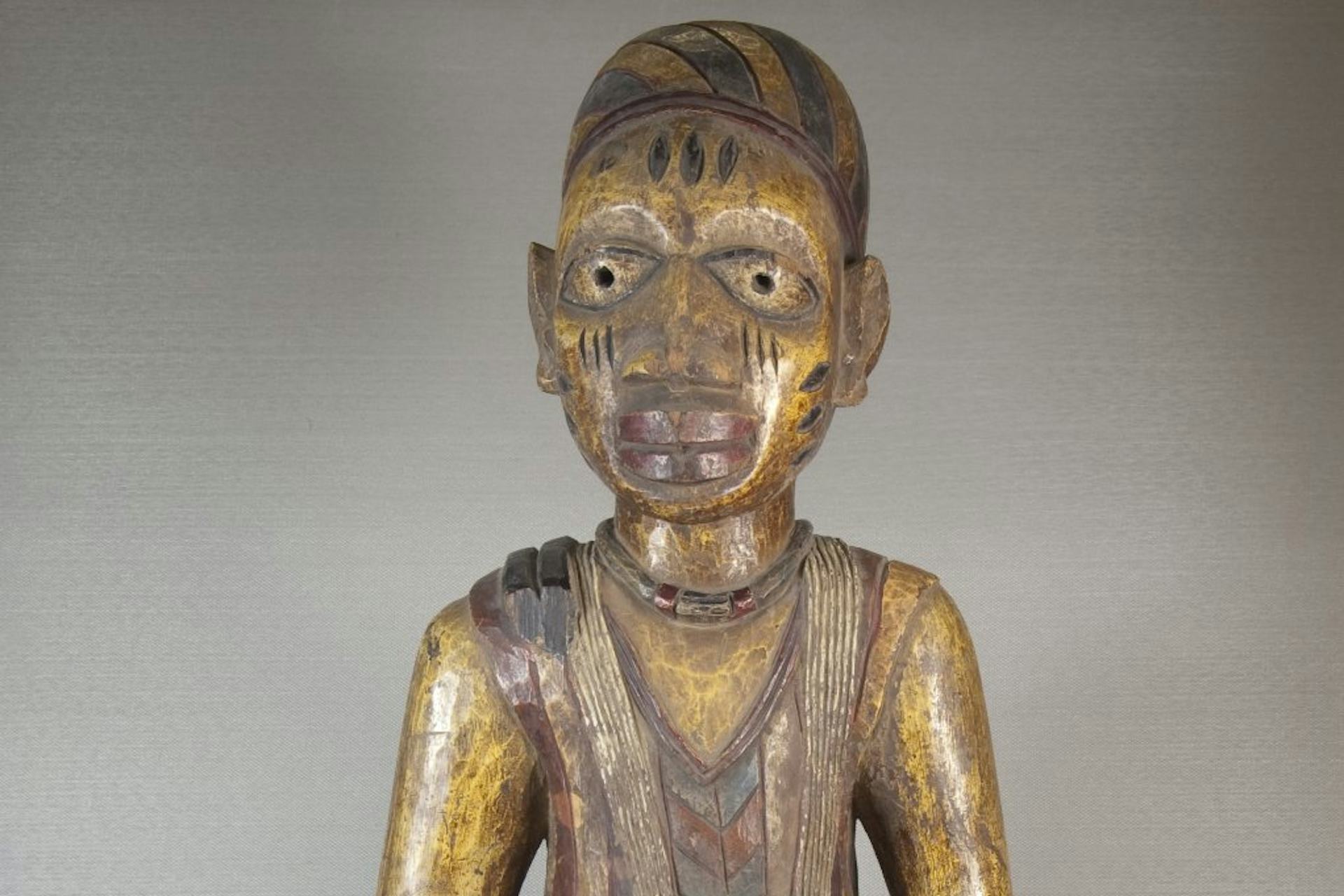
An altar figure for an Orisha by Yoruba artist (late 19th or early 20th century).
Brooklyn MuseumCC0Overview
The Yoruba religion is an ancient and vast belief system. It consists of a large corpus of myths and hundreds of orishas (gods), with religious knowledge passed down through oral tradition. The religion originated in a region once known as Yorubaland, which today corresponds to the countries of Nigeria, Benin, and Togo.
Cosmogony
Yoruba mythology states that before the creation of the earth, the universe consisted of nothing but the vast expanse of the heavens above and a watery wasteland below.[1] In this primordial state, the skies and marshy waters were much closer than they are now.[2]
Olorun (also known as Olodumare)—the supreme deity of the Yoruba religion—resided in the sky with the other orishas and ruled over both of these regions. Eventually, the primordial goddess Olokun was placed in charge of the marshy waters.
There are two accounts of how the world came to be. The first states that Olorun came up with the idea of creating a solid earth and assigned the task to his second-in-command, Ọbatala (“The King of the White Cloth”). However, another account states that Ọbatala proposed the idea to Olorun.[3]
In either case, it was Ọbatala who ultimately formed the earth. He was instructed to use a golden chain to descend from the sky and begin his work.[4] Ọbatala also received a snail shell filled with loose earth—the raw material for his new creation—as well as a hen and a pigeon to use as his tools.[5]
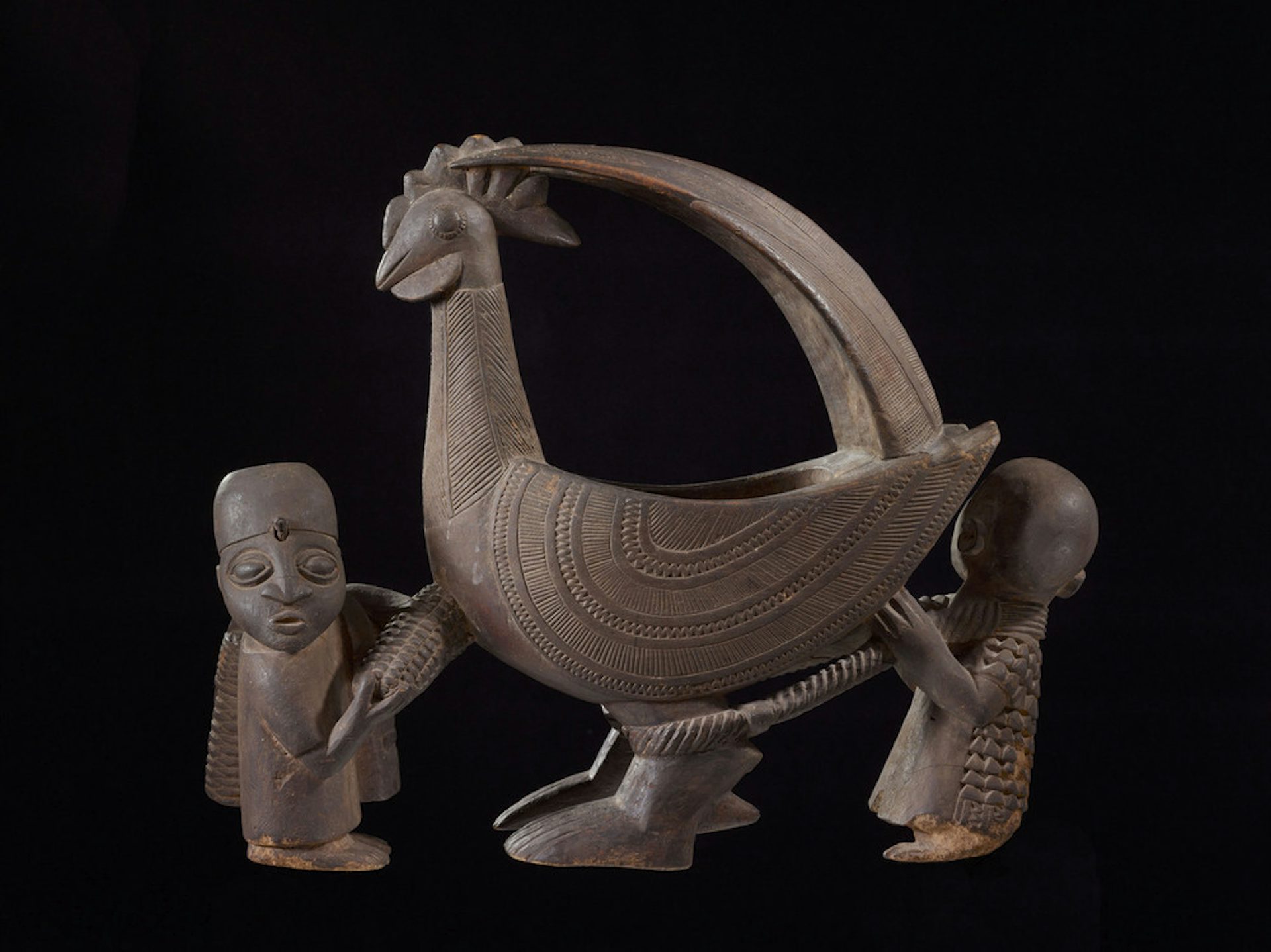
A chicken-shaped bowl used to store kola nuts, by Yoruba artist (1920 - 1940).
Museum RietbergCopyrightAfter descending, Ọbatala scattered the earth on the water and placed the birds upon it. The hen and pigeon then began to scratch at the earth, scattering it. Solid land formed wherever the earth fell. But when Olorun sent his servant, the chameleon Agemo, to inspect the earth, he found that it was not yet suitable for life.
Ọbatala tried again, this time at the site of Ile-Ife (a location that was more acceptable to Olorun). The creation of the earth is believed to have taken four days; the fifth day was set aside for the deities to rest and be worshipped.
Olorun gave Ọbatala a palm tree to plant on the earth so that its juices and seeds could sustain those who lived there. The hen and pigeon were also left on earth so they could multiply and provide meat.[6] To complete the earth, Olorun created the sun and rain.
Pantheon

A beaded and veiled crown (ade ileke) worn by Yoruba kings who trace their ancestry to Oduduwa, by Yoruba artist (19th century).
British MuseumCC BY-NC-SA 4.0The Yoruba gods are divided into three categories: primordial deities, natural deities, and deified ancestors. The primordial deities are the oldest gods, predating the creation of the world. Natural deities are gods of natural forces, such as the weather and plantlife. Finally, deified ancestors are former humans who became orishas when they died.
These gods are all ruled over by Olorun, the supreme being of the Yoruba religion.
Olorun
Olorun (also known as Olodumare) is the ruler of all orishas and the first deity to come into existence. He created the universe as well as the other primordial orishas, who are all said to be his children.[7]
Olorun is the god of justice: he judges the hearts of humans and decides when each human’s life will come to an end. Though he is omnipotent and observes daily life from above, he rarely interferes in human affairs or comes down to earth.
Primordial Orishas
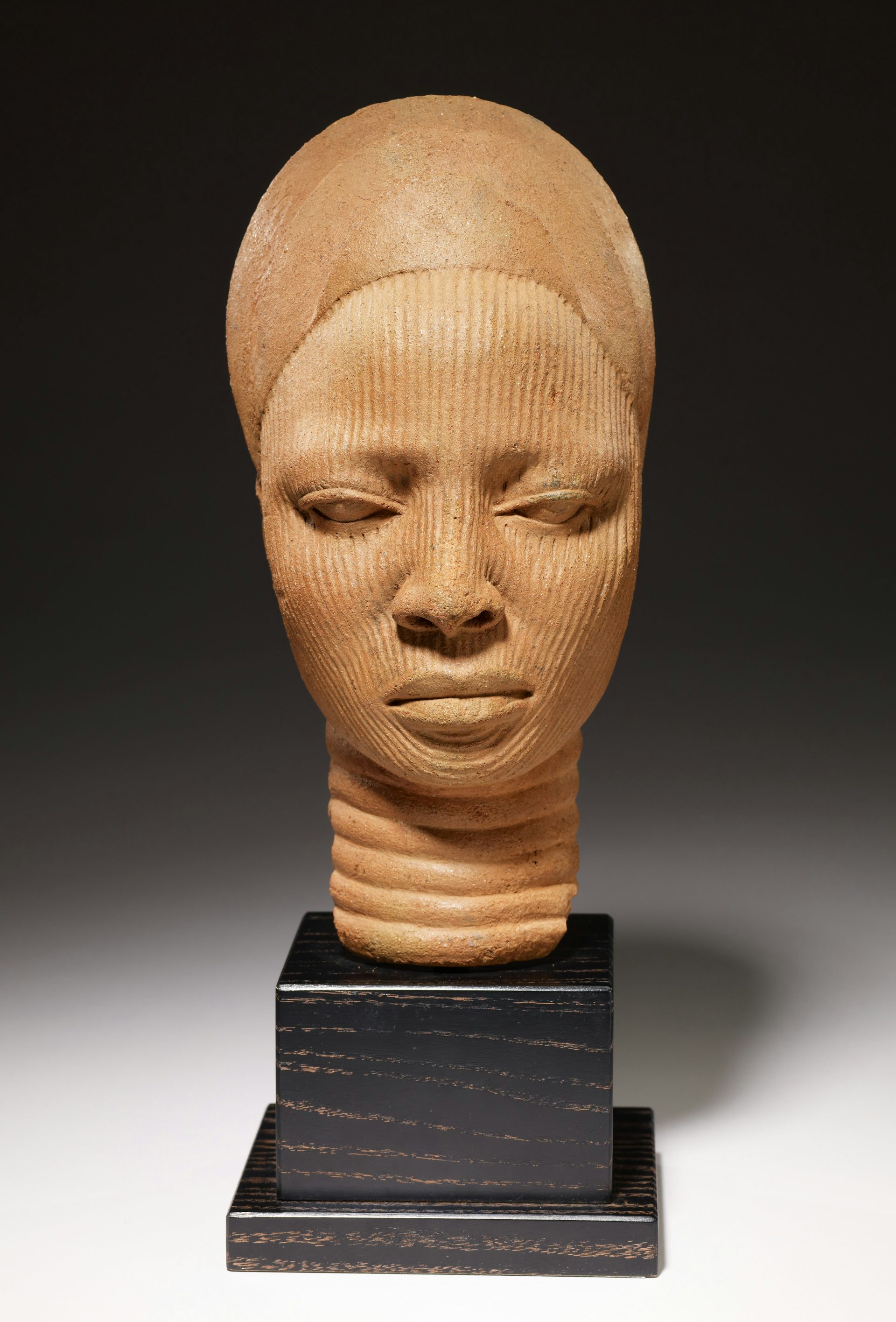
Terracotta shrine head from Ife, by Yoruba artist (12th-14th century).
MiA (Minneapolis)Public DomainThe primordial orishas—who are all children of Olorun—include Ọbatala, Oduduwa, Olokun, Yemaja, Ọrunmila (Ifa), and Eshu, among others. Ọbatala is Olorun’s right-hand man and is best known for creating the earth and humans. He is associated with purity and creativity.[8]
Ọbatala’s wife is named Oduduwa; the two of them are often represented as two halves of a single androgynous deity, symbolized by a white calabash (gourd). Like her husband, Oduduwa is also associated with the creation of humans; in fact, she is known as the mother of the Yoruba people. Some myths suggest that she was Olorun’s contemporary, meaning she was not created like the other gods.[9]
Olokun is the primordial deity of the waters upon which Ọbatala created the earth. At the beginning of the universe, she lived alone and undisturbed in the murky waters. Olokun was not at all pleased with the solid land that took over her realm and thus became vengeful toward the humans that inhabited it.[10]
Yemaja is the mother of all lesser orishas and the source of all water. She married her brother Aganju (Aginju), the god of the deserts. After being raped by her son Orangun, Yemaja gave birth to sixteen minor orishas, most of whom are natural deities (see below).[11]
Ọrunmila (Ifa) and Eshu are important to the practice of divination, a popular tradition among the Yoruba people. Ọrunmila is the god of divination and fate, while Eshu is the messenger and trickster god. Both deities travel between the realms of humans and gods, carrying messages and sacrifices between the two.[12]
Natural Orishas
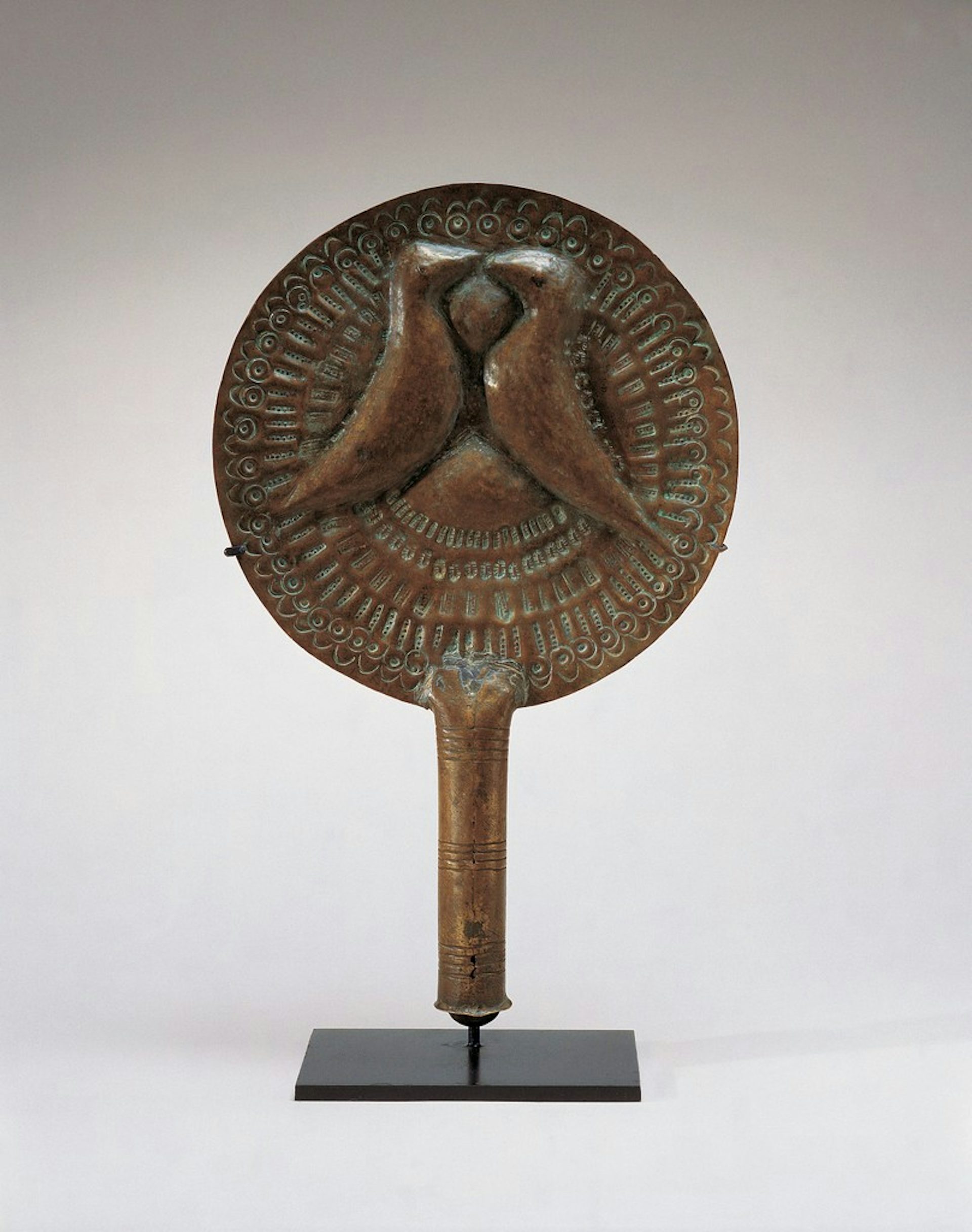
A brass fan created in honor of the goddess Osun, by Yoruba artist (late 19th –early 20th century).
High Museum of ArtCopyrightNatural orishas are connected with natural forces and elements, such as the wind, tornadoes, hurricanes, lakes, and rivers. Other nature gods are guardians of natural life, such as trees and plants. Among these natural deities are Oya, the goddess of violent winds, and Osanyin, the god of natural medicine and herbs.
Deified Ancestors
The third category of orishas is made up of deified ancestors—orishas who were once human but who were transformed into gods upon their death. The most well-known deified ancestor is Shango (Ṣango). According to mythology, Shango was originally a king of Oyo who inadvertently destroyed his kingdom by hurling lightning at it. After he died, Shango became the god of thunder and lightning.[13]
Mythology
Yoruba mythology is extensive and varied. Because it is grounded in oral tradition, scholars have recorded many different versions of the same myth, with new variations emerging over time. Stories sometimes shift based on geographic location as well. The myths below represent some of the most common tales and traditions within Yoruba culture.
How the Orishas Got Their Powers
According to Yoruba mythology, the orishas once lived on earth but did not yet possess their powers. When important knowledge was needed, the orishas asked Olorun or Ọrunmila for help. One day, Oko (Oriṣa-Oko) went to Ọrunmila and asked him what made him different from all the other people living on earth.
Wanting to distinguish himself, Oko requested that Olorun endow him with powers so that people could come to him for help as well. Ogun similarly turned to Ọrunmila and asked why he was not an orisha. One by one, the others approached Ọrunmila with the same request.
Overwhelmed by these demands for special powers, Ọrunmila turned to his servant Agemo for help. Agemo suggested leaving the matter to chance: he told Ọrunmila to throw down the special powers from heaven so that each orisha could catch his own, thus ensuring a fair distribution.
On the fifth day after their initial requests, the orishas gathered in a field. True to his word, Ọrunmila rained down special knowledge, and the orishas ran to gather their powers. Some, like Eshu, were faster than others and thus managed to gather more knowledge.[14]
The Creation of the Sun and Moon
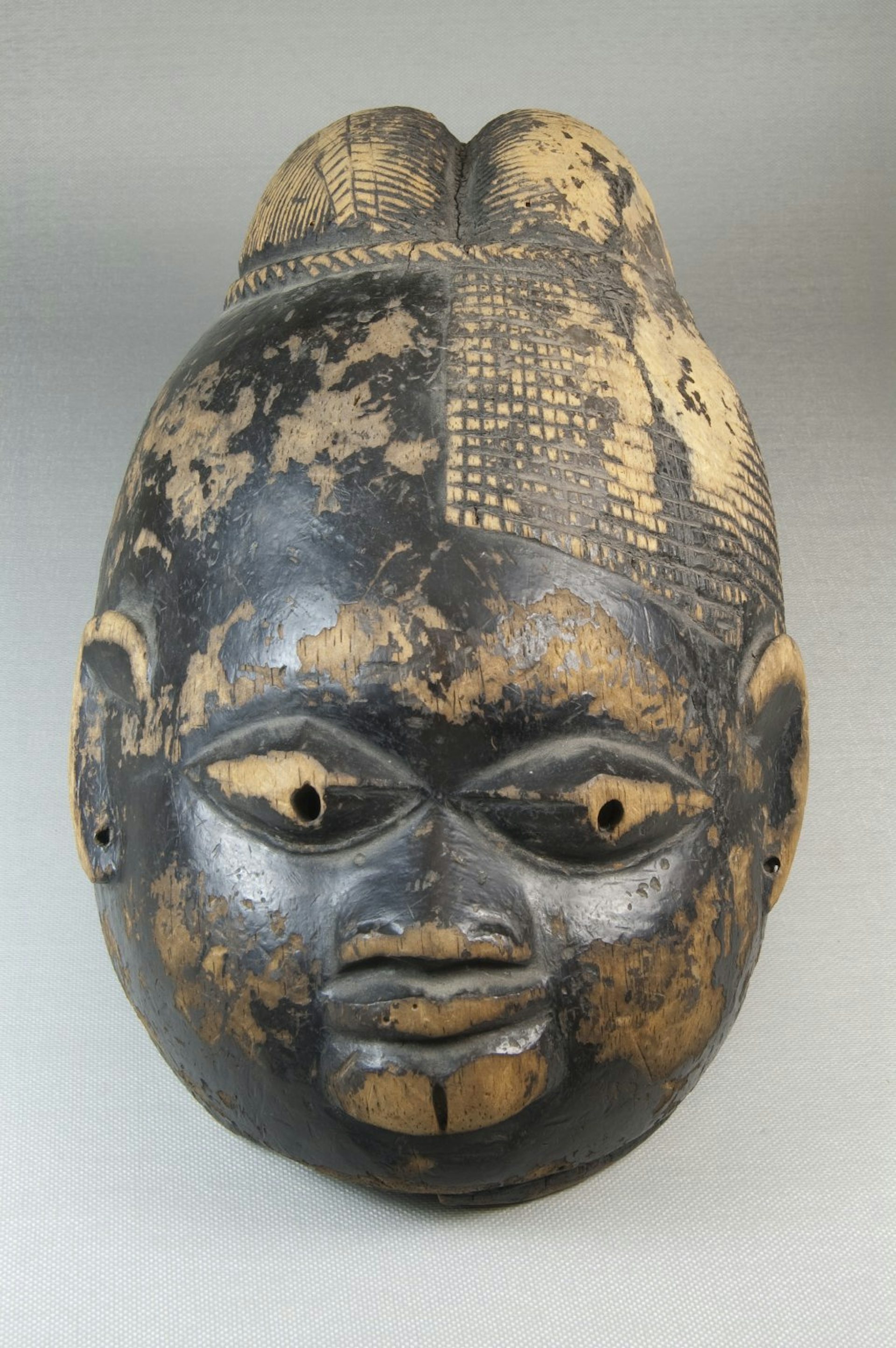
A Gelede Mask by Yoruba artist (late 19th - early 20th century).
Brooklyn MuseumCC0Legend states that the king of the forest once had an iroko tree (a type of hardwood tree found in West Africa). One day, the tree fell when the king forgot to make a sacrifice to the orishas. The god Ọbatala descended from heaven and transformed the tree into a secret precious metal.
Ọbatala called Ogun, the blacksmith of the orishas, and instructed him to make a jar and a boat from the new metal. He then summoned his slave, named “You-don’t-hear-what-I-say,” and ordered him to place the jar in the boat and travel with it “up to the top of the skies and back down again on the other side.”[15] This became the sun.
Next, Olorun created the moon in the shape of a flintstone, with one rounded side and one thin side. He sent the moon into the sky, where it slowly spins, “showing us its full round side only during three nights of the month.”[16]
The Creation of Humankind
In Yoruba mythology, the origin of humanity centers on Ile-Ife, the supposed site of creation. Ile-Ife was the “spot where God created man, both black and white” and is thought to be the first settlement of the Yoruba people.[17]
In most of the creation myths, Ọbatala is said to be responsible for creating and sculpting humans out of clay. However, one account states that Ọbatala became drunk on palm wine during his task, which caused him to misshape his creations.
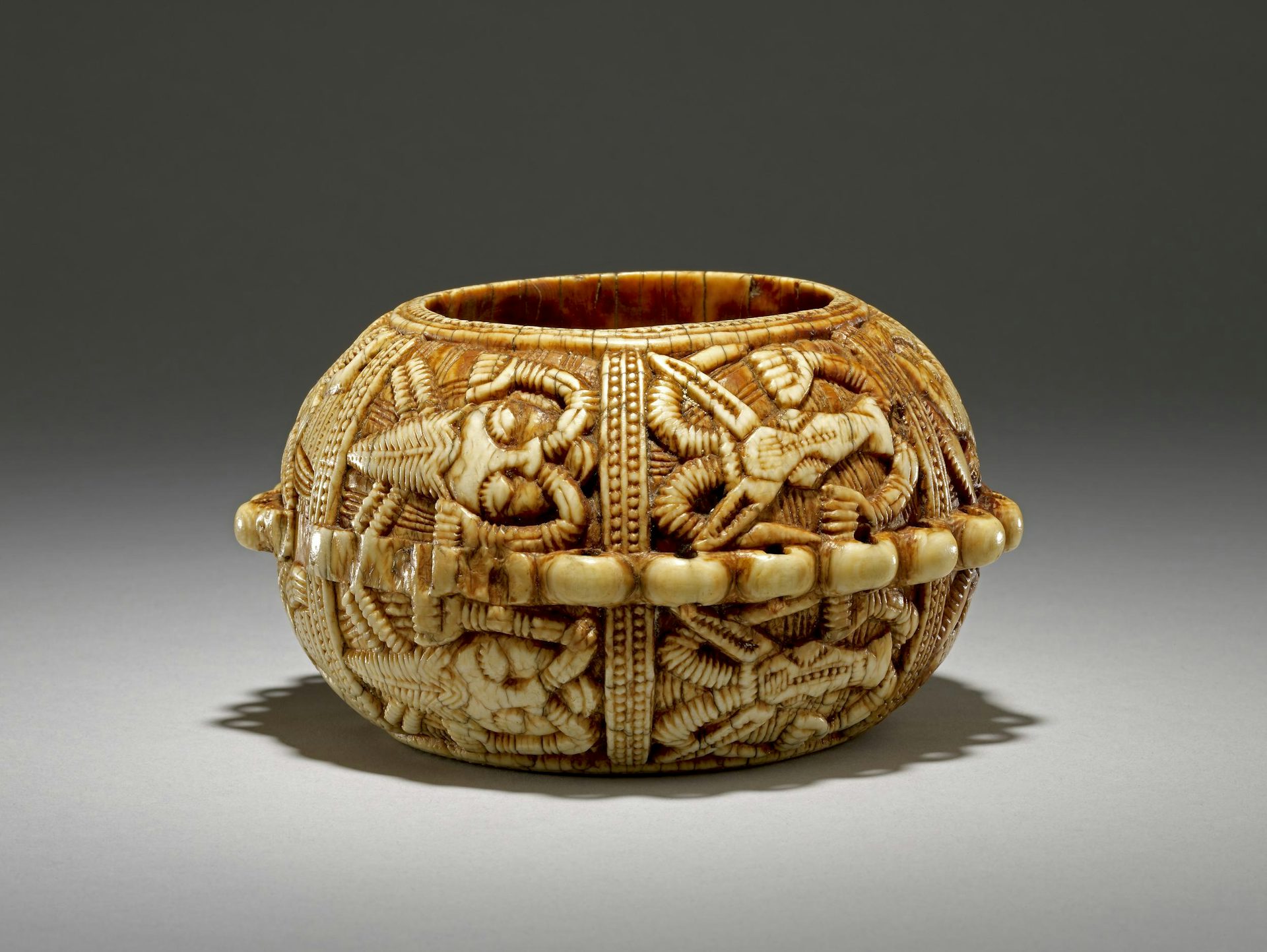
An ivory armlet depicting human and animal figures, by Yoruba artist (pre-1868).
British MuseumCC BY-NC-SA 4.0It is said that individuals with disabilities are the result of Obatala’s intoxication; these people are considered sacred to Ọbatala as a result. In the end, Oduduwa (Obatala’s wife) took over from the drunken Ọbatala and completed the sculpting. She is therefore regarded as the mother of the Yoruba people.[18]
The Origin of Thunderstorms
Yoruba mythology contains many aetiological myths—myths that provide explanations for events found in nature. The deification of Shango is one such myth, designed to explain the appearance of thunder and lightning.
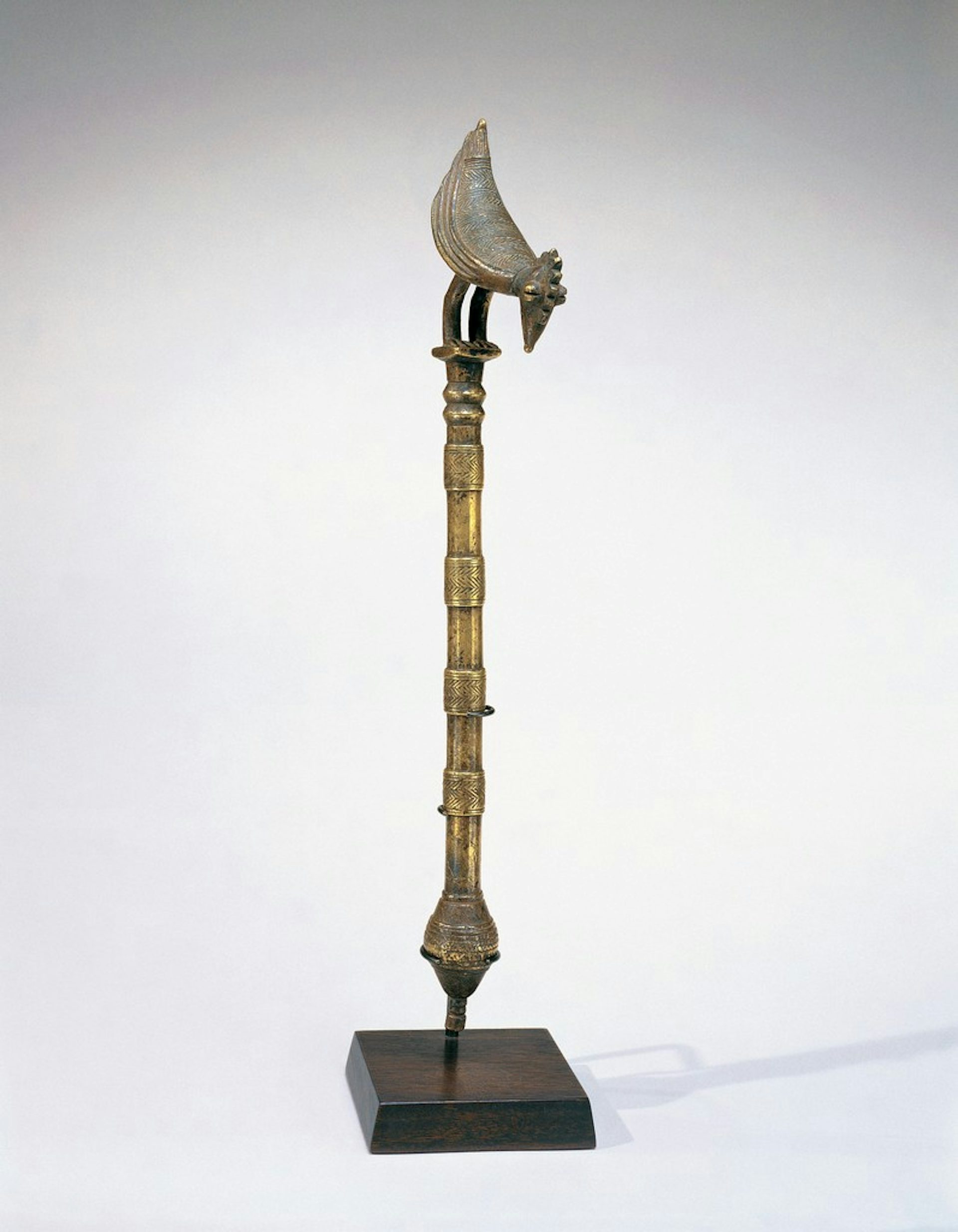
A bronze scepter presented to a Yoruba king of his coronation day, by Yoruba artist (late nineteenth–early twentieth century).
High Museum of ArtCopyrightAccording to this myth, Shango was once the tyrant king of Oyo. One day, he found a magical stone that could be used to summon lightning. But when he tried to test the power of the talisman, he accidentally destroyed his own palace with his family inside. Grief-stricken, Shango hanged himself. He was then made into a god after his death—the god of thunder and lightning.[19]
The aetiological myth explaining the origin of violent storm winds is also related to Shango. According to this legend, Oya, Shango’s wife and the goddess of wind, was fearful of her husband. She continually fled from him, and he pursued her each time. As a result, storm winds and hurricanes always precede thunder and lightning.[20]
Beliefs and Worship
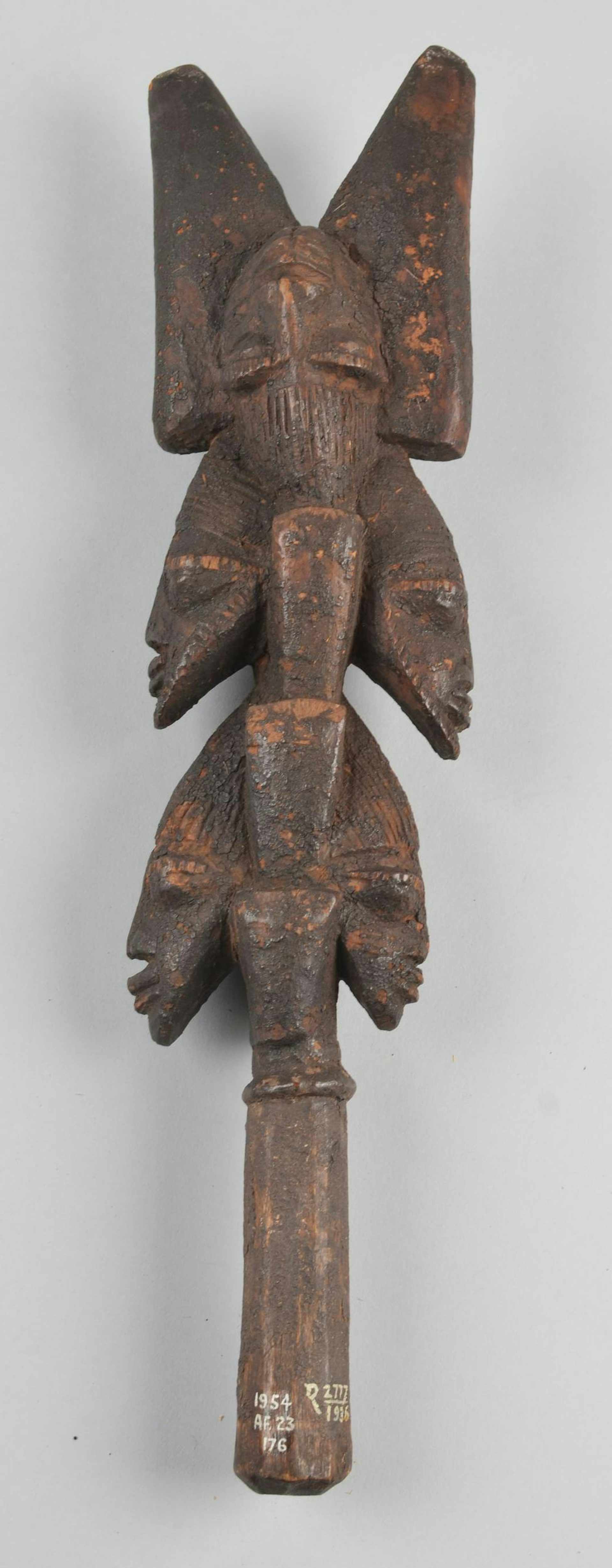
Carved Oshe Shango baton, by Yoruba artist (n.d).
British MuseumCC BY-NC-SA 4.0Ifa Divination
One important practice within the Yoruba religion is Ifa divination, a ritual through which worshippers receive guidance and insight from the gods. The ritual is centered around Ọrunmila (also called Ifa), the god of divination and oracles. Priests of Ifa, known as babalawos, serve as a mouthpiece for the god; they interpret his signs using an extensive corpus of texts and mathematical formulas.
People who require assistance, either with everyday matters or important decisions, will go to a babalawo to seek Ifa’s advice. To complete the divination ritual, the babalawo requires a circular divination board (Opon Ifa) and sixteen palm nuts (ikin).
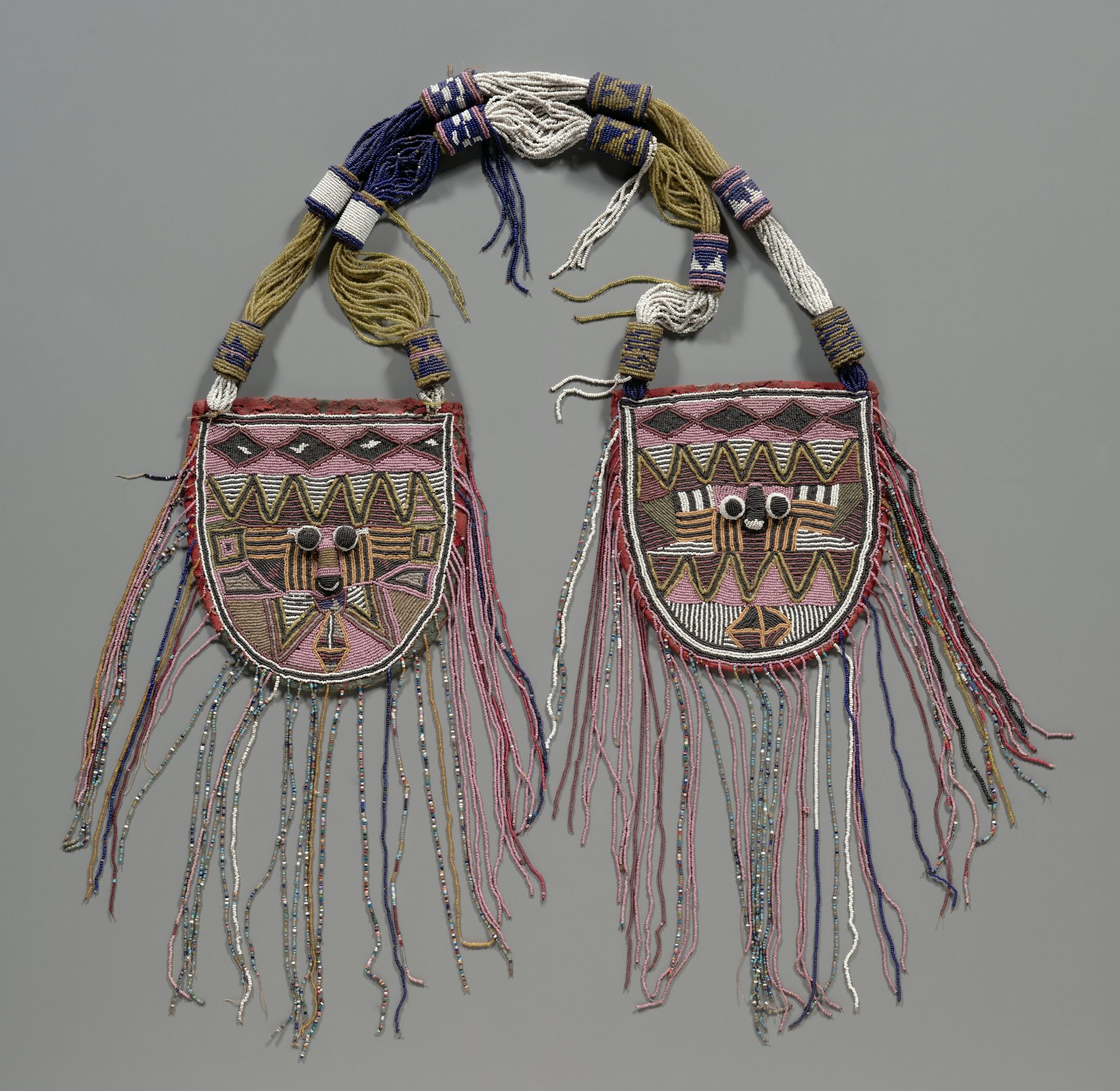
Ifá diviner's necklace (òdìgbà Ifá), by Yoruba artist (1900s).
Cleveland Museum of ArtCC0These divining tools are placed on a mound in the corner of a room and obscured from public view before the divination begins.[21] There are two methods of casting the palm nuts onto the board. For the first method, the diviner places all sixteen nuts on top of his left hand and tries to grab them with his right hand.
For the second method, the babalawo will hold the nuts loosely in his right hand and “throw them through half-closed fingers into the left hand.”[22] This process is repeated eight times.
Each outcome is known as an Odu and corresponds to a verse from Ifa literature. When a particular Odu appears on the divining board, the babalawo recites the phrase or story associated with it. In this way, the worshipper receives guidance from Ifa (albeit in a veiled form requiring interpretation).[23]
Egungun Cult
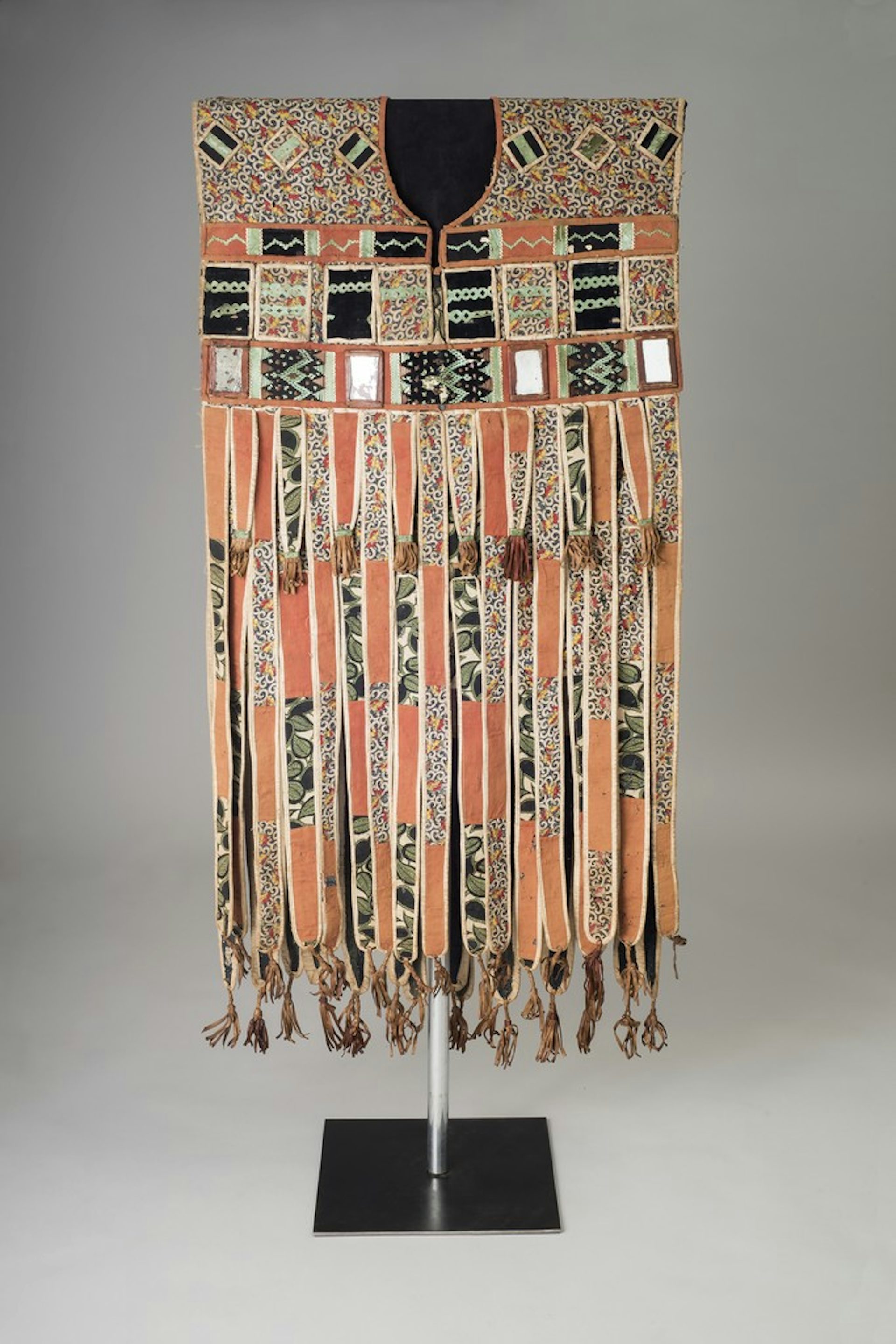
Tunic used in the Egungun cult, by Yoruba artist (early 20th century).
High Museum of ArtCopyrightYoruba religion also features the Egungun cult, which emphasizes the importance of departed family members. An Egungun “is regarded as an embodiment of the spirit of a deceased person who returns from heaven to visit his people.”[24] The cult is thus dedicated to the spirits of the departed, who are believed to always be around.[25]
At festivals of the cult, the Egungun is represented by a person wearing an Egungun mask. This person must be covered from head to toe, with no part of the body visible to others. To further hide his or her identity, the person representing the ancestor must also speak in a guttural voice.
The purpose of this cult is to keep the ancestors involved in family matters and to call on them in times of need.[26]
Gelede

An example of Brazilian Candomble Orixa Worship, by Toluaye (2008).
Wikimedia CommonsPublic DomainThe spirits of the Gelede cult are similar to those of the Egungun. However, the Gelede spirits are only invoked on festival occasions, and only by members of the cult.
Like the Egungun, the Gelede is represented by a living person during festivals. This person is required to wear a “clean and close-fitting dress and a wooden mask, the top of which is exquisitely carved in wood and well ornamented.”[27] The mask is usually carved in the shape of a man or woman painted with tribal marks, though it sometimes has the likeness of an animal.
During the festivities of the Gelede cult, worshippers parade through the streets accompanied by music. The cult is ultimately one of celebration and merriment.
Yoruba Diaspora
The transatlantic slave trade saw many Yoruba people shipped across the Atlantic as slaves. This led to a large influx of traditional Yoruba beliefs into the Americas, which were then combined with beliefs already present in those regions (especially Catholicism).
Santería and Lucumí
Santería and Lucumí are religions practiced in Cuba, representing a syncretism of Yoruba beliefs and Catholicism. The Yoruba orishas were adopted as deities into Santería and Lucumí, though many of them received new roles in their new home.
The names of Yoruba deities changed as their roles and relative importance shifted in these new religions. For example, Eshu, the Yoruba trickster god, became Eleggua. Though the god’s function has remained fundamentally the same, he has also gained new attributes.[28]
Eleggua’s position as the god of pathways and entranceways, for instance, is more significant in Santería than it is in traditional Yoruba religion. Practitioners of Santería believe that Eleggua must be consulted at the beginning of every ritual.
Candomblé
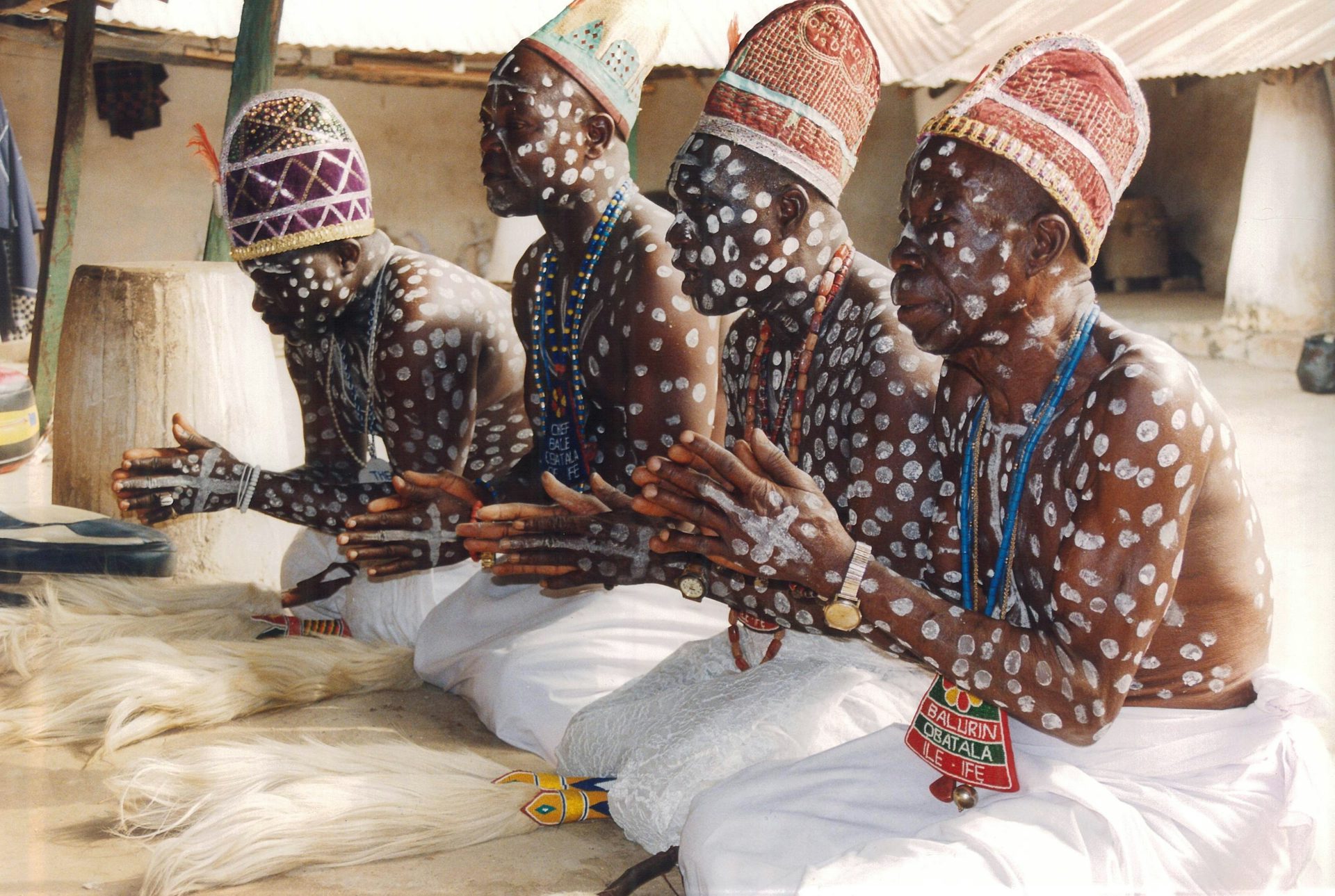
Priests of Obatala in their temple in Ife, by Dierk Lange (2000).
Wikimedia CommonsCC BY-SA 2.5Candomblé is the syncretic religion of Brazil; it is a fusion of traditional Yoruba beliefs with Christianity. The Candomblé gods are known as orixas rather than orishas, and many of these gods have different names. Eshu, for example, is called Exu, while Yemoja is known as Iemanja.
The Candomblé orixas also have characteristics of Catholic saints. Iemanja, for instance, is often identified with the Virgin Mary, and her attributes mainly focus on her maternal role.
Popular Culture
The Yoruba orishas and their diasporic religions have found their way into American pop culture. The television series American Gods, for example (based on the novel by Neil Gaiman), portrays some notable orishas, including Oshun, Yemoja, and Aje. In the third season of the show, Shango (referred to here as Chango) appears as the god of iron and thunder.
Another television series, American Horror Story: Coven, features numerous depictions of Haitian Vodou, a syncretic religion that combines elements of Yoruba beliefs and Catholicism. Papa Legba, the Haitian version of the god Eshu, serves as the antagonist of the series.
During a live performance at the 2017 Grammy Awards, singer Beyoncé wore an elaborate gold ensemble meant to embody the Yoruba goddess Oshun.